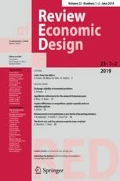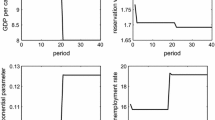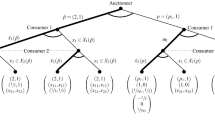Abstract
We study a market search equilibrium with aggregate uncertainty, private information and heterogeneous beliefs that are initially optimistic. Despite these biased beliefs, it is shown that all optimistic equilibria converge to perfect competition in the limit as the time between matches tends to 0.



Similar content being viewed by others
Notes
For example, see Rogerson et al. (2005) for a discussion of its relevance in labor markets.
Several authors have considered steady-state models with common value uncertainty, and double auction bargaining with a grid restricted set of price offers. In such a model, Wolinsky (1988) assumes two-sided incomplete information and obtains a negative convergence result, while Serrano and Yosha (1993) assume one-sided incomplete information and show existence of a convergent equilibrium. In addition, Blouin and Serrano (2001) consider a market with one-time entry of agents and obtain strong negative results concerning convergence. However, recently, Gottardi and Serrano (2005) revisit the issue and obtain some positive results in a somewhat different model. In addition, the seminal contributions of Reny and Perry (2006) and Pesendorfer and Swinkels (1997, 2000) provide foundations for a rational expectations equilibria in static models of centralized double-auction trade with interdependent values. Recently, there has been a renewed interest in common-value information aggregation in financial markets, see e.g. Duffie et al. (2009), Golosov et al. (2009) and Ostrovsky (2009). Most other papers have adopted a private values paradigm with no aggregate uncertainty; a non-exhaustive list includes Butters (1979), Gale (1986, 1987, 2000), Rubinstein and Wolinsky (1985), Wolinsky (1988, 1990), Rubinstein and Wolinsky (1990), McLennan and Sonnenschein (1991), Dagan et al. (1998, 2000), De Fraja and Sakovics (2001), Moreno and Wooders (2002), Serrano (2002), Mortensen and Wright (2002), Satterthwaite and Shneyerov (2007, 2008), Atakan (2009), Lauermann (2009), and Shneyerov and Wong (2010a, b).
This is the random-proposer protocol of Rubinstein and Wolinsky (1985). Several papers in the literature have considered other bargaining protocols, notably the k-double auction (k-DA) with grid-restricted price offers. Some references are given below. However, for a k-DA with unrestricted price offers, Shneyerov and Wong (2010a) show existence of non-convergent equilibria even without aggregate uncertainty as here.
For any real-valued function \(x_{\tau }:\mathcal {\mathbf {\mathbb {R}}}_{+}\rightarrow \mathfrak {\mathsf {\mathbb {\mathcal {\mathbf {\mathbb {R}}}}}_{+}}\), we say that \(x_{\tau }\) is asymptotically proportionate to \(\tau \), and write \(x_{\tau }\asymp \tau \) if, as \(\tau \rightarrow 0\), the ratio \(x_{\tau }/\tau \) is bounded away from both 0 and infinity, i.e. \(lim_{\tau \rightarrow 0}\, inf\, x_{\tau }/\tau >0\) and \(lim_{\tau \rightarrow 0}\, sup\, x_{\tau }/\tau <\infty \).
We assume that, whenever indifferent, traders choose to participate.
References
Atakan A (2009) Competitive equilibria in decentralized matching with incomplete information. Working paper, Northwestern University
Blouin MR, Serrano R (2001) A decentralized market with common values uncertainty: non-steady states. Rev Econ Stud 68(2):323–346
Butters GR (1979) Equilibrium price distributions in a random meetings market. Working paper
Dagan N, Serrano R, Volij O (1998) Comment on Mclennan and Sonnenschein “Sequential bargaining as a noncooperative foundation for Walrasian equilibrium”. Econometrica 66(5):1231–1233
Dagan N, Serrano R, Volij O (2000) Bargaining, coalitions and competition. Econ Theory 15:279–296
De Fraja G, Sakovics J (2001) Walras retrouve: decentralized trading mechanisms and the competitive price. J Polit Econ 109(4):842–863
Duffie D, Malamud S, Manso G (2009) Information percolation with equilibrium search dynamics. Econometrica 77(5):1513–1574 ISSN 1468-0262
Gale D (1986) Bargaining and competition part I: characterization. Econometrica 54(4):785–806
Gale D (1987) Limit theorems for markets with sequential bargaining. J Econ Theory 43(1):20–54
Gale D (2000) Strategic foundations of general equilibrium: dynamic matching and bargaining games. Cambridge University Press, Cambridge
Golosov M, Lorenzoni G, Tsyvinski A (2009) Decentralized trading with private information. NBER working paper
Gottardi P, Serrano R (2005) Market power and information revelation in dynamic trading. J Eur Econ Assoc 3(6):1279–1317
Lauermann S (2009) Dynamic matching and bargaining games: a general approach. Working paper, University of Michigan
Lauermann S, Merzyn W, Virag G (2012) Aggregate uncertainty and learning in a search model. Working paper
McLennan A, Sonnenschein H (1991) Sequential bargaining as a noncooperative foundation for Walrasian equilibrium. Econom J Econom Soc 59(5):1395–1424
Moreno D, Wooders J (2002) Prices, delay, and the dynamics of trade. J Econ Theory 104(2):304–339
Mortensen DT, Wright R (2002) Competitive pricing and efficiency in search equilibrium. Int Econ Rev 43(1):1–20
Ostrovsky M (2009) Information aggregation in dynamic markets with strategic traders. In: Proceedings of the tenth ACM conference on electronic commerce, pp 253–254. ACM
Pesendorfer W, Swinkels JM (1997) The loser’s curse and information aggregation in common value auctions. Econom J Econom Soc 65(6):1247–1281
Pesendorfer W, Swinkels JM (2000) Efficiency and information aggregation in auctions. American Economic Review, pp 499–525
Reny PJ, Perry M (2006) Toward a strategic foundation for rational expectations equilibrium. Econometrica 74(3):1231–1269
Rogerson R, Shimer R, Wright R (2005) Search-theoretic models of the labor market: a survey. J Econ Lit 43(4):959–988
Rubinstein A, Wolinsky A (1985) Equilibrium in a market with sequential bargaining. Econometrica 53(5):1133–1150
Rubinstein A, Wolinsky A (1990) Decentralized trading, strategic behaviour and the Walrasian outcome. Rev Econ Stud 57(1):63–78
Satterthwaite M, Shneyerov A (2007) Dynamic matching, two-sided incomplete information, and participation costs: existence and convergence to perfect competition. Econometrica 75(1):155–200
Satterthwaite MA, Shneyerov A (2008) Convergence to perfect competition of a dynamic matching and bargaining market with two-sided incomplete information and exogenous exit rate. Games Econ Behav 63(2):435–467
Serrano R (2002) Decentralized information and the Walrasian outcome: a pairwise meetings market with private values. J Math Econ 38(1):65–89
Serrano R, Yosha O (1993) Information revelation in a market with pairwise meetings: the one sided information case. Econ Theory 3(3):481–499
Shneyerov A, Wong ACL (2010a) The rate of convergence to perfect competition of matching and bargaining mechanisms. J Econ Theory 145(3):1164–1187
Shneyerov A, Wong ACL (2010b) Bilateral matching and bargaining with private information. Games Econ Behav 68(2):748–762. doi:10.1016/j.geb.2009.10.005
Shneyerov A, Wong A (2011) The role of private information in dynamic matching and bargaining: can it be good for efficiency? Econ Lett 124(2):314–317
Thanassoulis John (2010) Optimal stalling when bargaining. J Econ Dyn Control 34(2):101–120
Wolinsky A (1988) Dynamic markets with competitive bidding. Rev Econ Stud 55(1):71–84
Wolinsky A (1990) Information revelation in a market with pairwise meetings. Econometrica 58(1):1–23
Yildiz M (2003) Bargaining without a common prior—an immediate agreement theorem. Econometrica 71(3):793–811
Yildiz M (2004) Waiting to persuade. Q J Econ 119(1):223–248
Author information
Authors and Affiliations
Corresponding author
Additional information
This project was inspired by the second author’s conversations with Mark Satterthwaite. We are grateful to the participants at the 2010 World Congress of the Econometric Society in Shanghai and the 2010 Fall Midwest Theory Meeting at the University of Wisconsin, as well as seminar participants at University of Michigan and University of Hong Kong for their comments. The second author acknowledges financial support from SSHRC Grant 410-2010-1991.
Appendix
Appendix
Proof of Proposition 1
Equations (18) and (19) imply that in a full trade equilibrium, the stock of pessimistic buyers is equal to the stock of sellers,
where
Equation (23) is equivalent to
which upon the substitution of (40) for \(B^{0}\left( L|H\right) \) can be solved for \(B\left( H|H\right) \),
Substituting (40) and (41) into (21) gives us the solution for \(B^{1}\left( L|H\right) \) and
and the other stocks \(B^{0}\left( L|H\right) \), \(B\left( H|H\right) \) are then determined from (40) and (41). The probability of meeting a pessimistic buyer is
The entry equation, say (19) in \(\mu =H\) is then equivalent to
For \(\mu =L\) we obtain in parallel
The marginal types must also satisfy the mass balance conditions (20) and (25), and for \(\mu \in \left\{ H,L\right\} \),
Equations (43) and (44), together with the mass balance conditions (20) and (25), form a system of four equations for 4 unknowns, now denoted as \(\left( \underline{v}_{\tau }\left( H\right) ,\bar{c}_{\tau }\left( H\right) ,\right. \left. \underline{v}_{\tau }\left( L\right) ,\bar{c}_{\tau }\left( L\right) \right) \). For \(\tau =0\), these equations imply
The Implicit Function Theorem implies that \(\bar{\tau }>0\) exists such that a solution exists for all \(\tau \in [0,\bar{\tau }]\) provided the Jacobian of this system is nonzero. Moreover, as \(\tau \rightarrow 0\), the marginal types converge to the corresponding Walrasian prices, \(\underline{v}(H),\bar{c}(H)\rightarrow p_{W}\left( H\right) \) and \(\underline{v}(L),\bar{c}(L)\rightarrow p_{W}\left( L\right) \).
To evaluate the Jacobian, it is convenient to reduce this system by eliminating \(\bar{c}\left( \mu \right) \) from Eqs. (20) and (25):
where the mapping \(\phi \left( \cdot |\mu \right) :\left[ p_{W}\left( \mu \right) ,1\right] \rightarrow \left[ 0,p_{W}\left( \mu \right) \right] \) (smoothly extended to an open \(\varepsilon \) neighborhood of \(p_{W}\left( \mu \right) \)) has the derivative at \(p_{W}\left( \mu \right) \) equal to
Now the system of Equations for \((\underline{v}\left( H\right) ,\underline{v}\left( L\right) )\) becomes
The Jacobian of this system at \(\tau =0\) is
where the inequality in the last line follows from (46). Q. E. D. \(\square \)
Lemma 1
A threshold \(\bar{r}>0\) exists such that, for all \(r\in \left[ 0,\bar{r}\right] \) and \(\tau <1\), buyers do not have an incentive to deviate by offering prices p that are not acceptable to some active sellers who share the same belief about \(\mu \):
Likewise, sellers do not have an incentive to deviate by offering prices p that are not acceptable to some of the buyers who share the same belief about \(\mu \):
Proof
Without loss of generality, let’s assume that the state is \(\mu =H\) and focus on the seller. Whenever the corresponding stocks are positive we denote the distribution of active buyer types with belief \(\mu _{B}\) when the true state is \(\mu \) as \(\Phi \left( \cdot |\mu _{B},\mu \right) \), while the distributions of their reservation values \(\tilde{v}\left( v|\mu _{B}\right) \) are denoted as \(\tilde{\Phi }\left( \cdot |\mu _{B},\mu \right) \).
For notational expedience, from now on we denote the probability that a buyer with belief \(\mu _{B}=H\) will meet a seller as
where the second equality follows from (30).
The proposing strategies must be non-decreasing by standard single-crossing arguments; the proof parallels Lemma 2 in Shneyerov and Wong (2010b) and is omitted. It is therefore sufficient to show that the marginal types will not deviate. First, we focus on the incentives of the sellers (a symmetric argument will apply for the buyers, with obvious changes). The expected profit contingent on proposing \(\lambda \ge \underline{v}\left( \mu \right) \) is
and its slope is
where \(\tilde{J}_{B}\left( \lambda |\mu \right) \) is the “virtual type” that corresponds to the distribution of reservation values \(\tilde{\Phi }\left( \cdot |\mu ,\mu \right) \),
Notice that \(\tilde{\Phi }\left( \lambda |\mu ,\mu \right) =\Phi \left( \tilde{v}^{-1}(\lambda |\mu )|\mu ,\mu \right) \). Contingent on meeting a seller, pessimistic buyers trade with probability 1 regardless of their type. Therefore, their distribution of types in the market is a truncation of the inflow distribution,
From (34), \(\tilde{v}\left( v|\mu \right) \) is a linear function with the slope
Since \(\tilde{v}\left( \underline{v}\left( \mu \right) |\mu \right) =\underline{v}\left( \mu \right) \), we can explicitly solve for the responding strategy,
From (34), the inverse responding strategy is
Then
and
Equivalently,
Substituting (51) in the slope formula (49), we obtain
Clearly, a deviation to \(\lambda <\underline{v}\left( \mu \right) \) is not profitable, so we only need to consider \(\lambda >\underline{v}\left( \mu \right) \). A necessary condition for such a deviation to be not profitable is that \(\partial \pi _{S}\left( \bar{c}\left( \mu \right) ,\lambda |\mu \right) /\partial \lambda \le 0\) at \(\lambda =\underline{v}\left( \mu \right) \), i.e. the expression in the brackets on the right-hand side of Eq. (52) is non-negative when \(\lambda =\underline{v}\left( \mu \right) \). This is also sufficient because of the assumed monotonicity of \(J_{B}\left( \cdot |\mu \right) \) (Assumption 1). This gives us the inequality
We now show that this inequality is satisfied for small r. We can rewrite it as
From either (18) or (19) we have \(\underline{v}\left( \mu \right) -\bar{c}\left( \mu \right) =2\tau \kappa /\ell _{B}^{*}\). Substituting this into (53) and replacing \(\frac{1-G_{B}\left( \underline{v}\left( \mu \right) |H\right) }{g_{B}\left( \underline{v}\left( \mu \right) |H\right) }\) with an upper bound \(1/\underline{g}_{B}\), and \(\left( 1-R_{\tau }\right) +R_{\tau }\ell _{B}^{*}\) with \(R_{\tau }\ell _{B}^{*}\), we have a stronger inequality that is sufficient for no deviation:
Alternatively,
The l.h.s. of the above equation, \(\left( e^{r\tau }-1\right) /\tau \), is an increasing function of \(\tau \) because \(e^{r\tau }-1\) is a convex, increasing function of \(\tau \) taking value 0 at \(\tau =0\). Therefore, if \(\tau \le 1\), it is sufficient to require
or equivalently
A parallel argument applied to marginal sellers. Q. E. D. \(\square \)
Rights and permissions
About this article
Cite this article
Majumdar, D., Shneyerov, A. & Xie, H. An optimistic search equilibrium. Rev Econ Design 20, 89–114 (2016). https://doi.org/10.1007/s10058-015-0182-9
Received:
Accepted:
Published:
Issue Date:
DOI: https://doi.org/10.1007/s10058-015-0182-9




